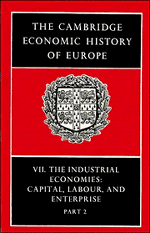CHAPTER II - The United States: Evolution of Enterprise
from THE UNITED STATES
Published online by Cambridge University Press: 28 March 2008
Summary
Introduction: Modern Business Enterprise
Large business enterprises have come to dominate American production, distribution, transportation, finance, and services. Such enterprises have been products of, and prime movers in, the rapid industrialization of the United States. Indeed, this new institutional form now plays a major role in all the urban and industrial economies of the non-Communist world. Giant business organizations have become hallmarks of the twentieth century.
Modern business enterprise makes use of more workers, managers, owners, machines, materials, and money than any other economic institution in history. Because of its size, it is impersonal in tone and bureaucratic in organization. Its managers, workers, and owners cannot possibly come to know one another. Its control requires the creation of a carefully defined hierarchy of offices, each with its own functions and responsibilities. The lines of authority, responsibility, and communication among offices are also carefully defined. Detailed accounts and other statistical and financial data flow through these channels. Control through statistics has become a basic managerial art. The managers of these enterprises make their careers in a single industry and often in a single firm. They are rarely, if ever, owners of their enterprises, for nearly all the enterprises are ‘publicly owned’ corporations in a legal sense, and their stock is held by thousands or even tens of thousands of shareholders. In only 15.5 per cent of the 200 largest corporations in 1963 did an individual, family, or group hold as much as 10 per cent of the stock.
- Type
- Chapter
- Information
- The Cambridge Economic History of Europe , pp. 70 - 133Publisher: Cambridge University PressPrint publication year: 1978
References
- 5
- Cited by



